
From snow hiking to backcountry. The entrance to the wonderful snowy mountains, how to choose snowshoes wisely and 5 recommended models
Walking through the snow with snowshoes gives you a slightly more gentle world of snowy mountains.
The world of winter mountains, closed to deep snow, is certainly a world where it is difficult to allow you to step in casually. However, when you come here with great effort, the overwhelming beauty and preciousness of the majestic atmosphere that you would never encounter in your daily life will surely become a memory you will never forget. It feels as if the nature you've seen up until now becomes even deeper, and the way the world is seen without any flattering is changed. This Snowshoe Wakan is the easiest way to experience this snowy world.
There are a variety of snowshoes that fit a variety of winter activities that allow you to freely move around snowy areas, from winter forests and satoyama walking, to winter running and hiking up steep slopes in the backcountry, so it is important to choose the type of snowshoes that are suitable for you to play comfortably and safely.
Here we have investigated the latest information on the tools you need to enjoy snowshoe activities, and summarized wise choices based on your own experiences. I would like to introduce it to you right away.
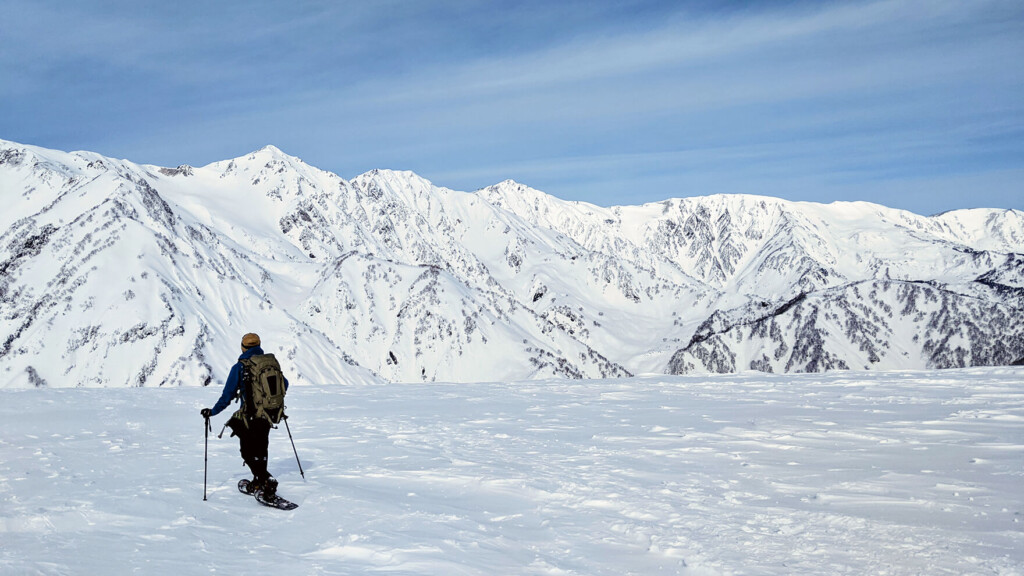
table of contents
- Introduction: What are snowshoes, when and where do you wear them?
- 5 points to check when choosing the best snowshoes
- Point 1: Find out the type and type of snowshoe that is suitable for your purpose and purpose
- Point 2: Choose the frame (& deck) with the optimal material, size and shape
- Point 3: Choose a binding that is easy to put on and take off and does not loosen
- Point 4: Check whether the clamp is strong enough to suit your needs
- Point 5: Weight and portability are also important depending on the purpose
- Recommended snowshoes by purpose and type - From snow hiking to backcountry
- Recommended snowshoes for backcountry: MSR Lightning Ascent
- Recommended snowshoes for all-around games: Atlas Range Series (MTN/BC)
- Recommended snowshoes for beginners: Atlas Helium TRAIL 23
- Snowshoes are comfortable to walk in and recommended for snowy mountain climbing: TSL SYMBIOZ hyperflex adjust
- Recommended snowshoes for cost performance: Captain Stag UX-950 CS Snowshoes TYPE II 22inc
- summary
Introduction: What are snowshoes, when and where do you wear them?
Snowshoes are walking equipment that allow you to walk without filling deep, untreated snowy ground. Its history is said to be the origin of the tools that humanity crafted to live in the harsh winter land several thousand years ago.
To understand why snowshoes can easily walk on snow, it is a good idea to think of a boat. Just like boats floating on the surface of the water, snowshoes are structured to widen the bottom of the shoe. The wide surface that comes into contact with the snow gives you a large "buoyancy," which allows your body to float without sinking even on the snow. Generally, the higher the load, or the lighter and dryer the snow quality, the more likely the person will sink, so snowshoes with a larger surface area are required.

Are snowshoes and Wakan different? ~It looks similar but a little different
It is said that snowshoes originated in Central Asia and spread around the world and adapted to various regions, but they have also undergone unique evolution in Japan. That is the folk tool "Kanjiki" that is passed down in Japan's snowy regions. Both Wakan and snowshoes are designed to make it easier to walk on the same snow, but since the environment and use of the two in the West and Japan are different, it is difficult to say which is better. However, in my personal experience, when using it for winter mountain climbing in Japan, Wakan has a relatively better advantage. Here we summarize this in the comparison table below (just a relative comparison with the average model).
| material | Snowshoes | Wakan |
|---|---|---|
| Representative image | 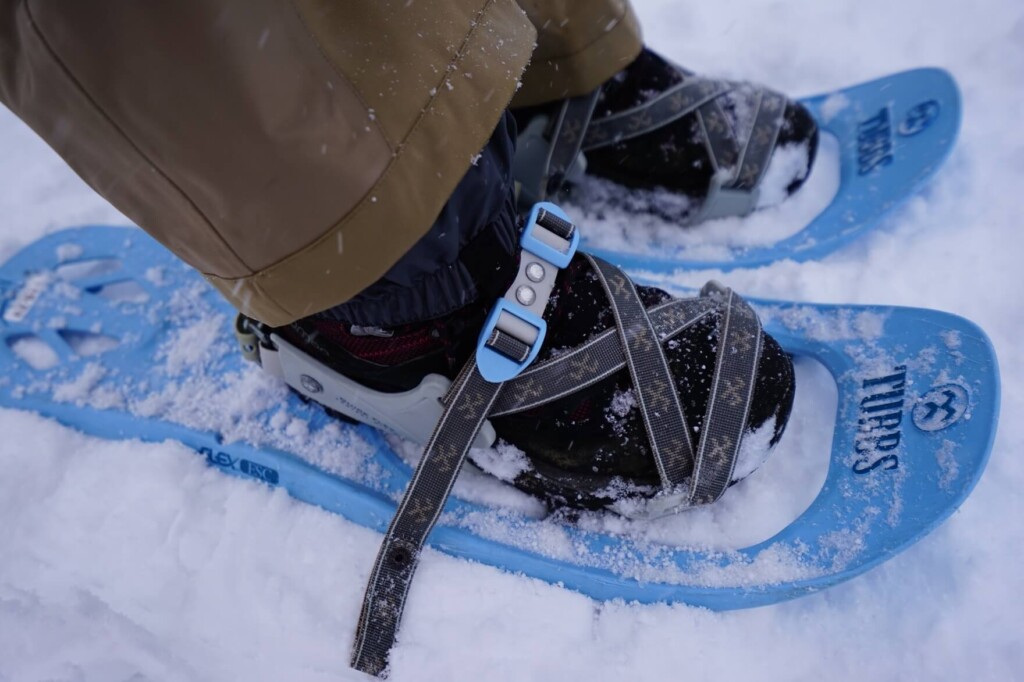 |  |
| Features | Basically, it is ideal for walking on dry snow, deep snow, or rather flat areas. | Ideal for walking on complex terrain and snowy qualities such as wet snow or steep slopes |
| merit |
|
|
| Disadvantages |
|
|
To sum up, in Japan where the terrain changes dramatically and heavy wet snowy, the combination of Wakan and Crampon has been used more frequently since ancient times, making it easier to use and more popular. However, it is also true that many people prefer snowshoes when trying to get backcountry snowboarding for powder, due to their ease of walking and the severity of buoyancy on flat ground. the MSR Lightning Ascent, recently been introduced that are light and strong on steep slopes.
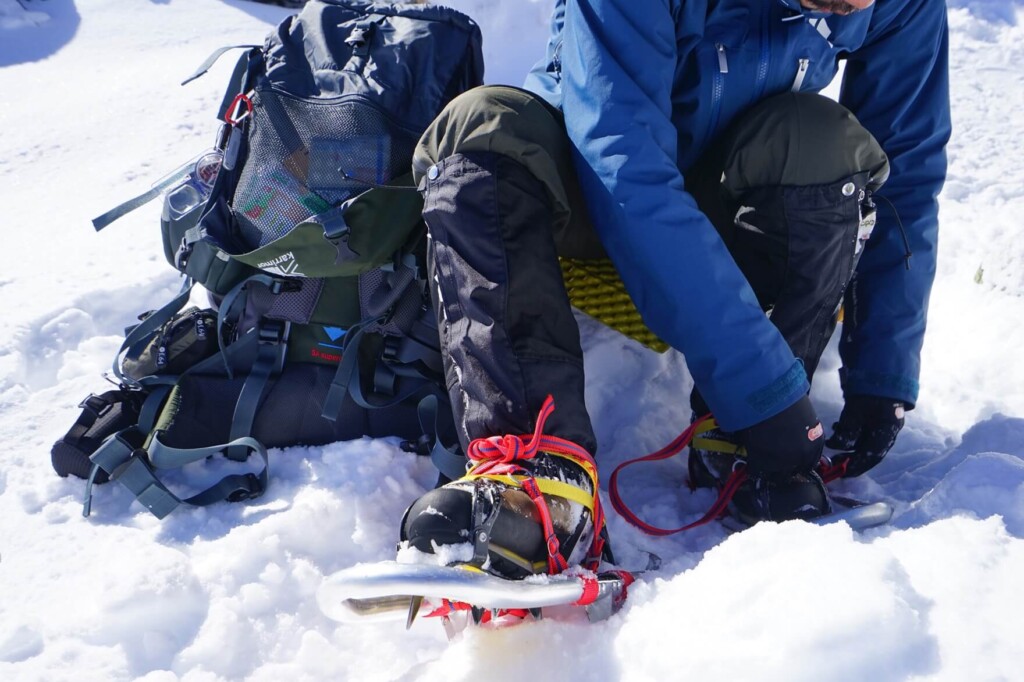
If you wear a hook over the clamp, you can flexibly adapt to a wide range of terrain, including deep snow and ice, making it safe.
What kind of shoes do you match?
Shoes for wearing snowshoes don't necessarily have to be robust and winter climbing boots with heat insulation.
To put it in extreme terms, it's okay to wear anything as long as it's fixed, but in general, I often wear "hiking and trekking boots made of waterproof and breathable material," "winter boots," or "winter climbing boots." However, if you use trekking boots for spring to autumn or with not-so-grade leather climbing boots, your feet may get cold, so in this case, you can use "overshoes" that are waterproof and breathable shoe covers that you wear over boots, like the link below.
What else do you need to enjoy snowshoes?
Generally, when playing with snowshoes, poles (stocks) are used just like skiing or hiking.
You can't walk without using stock, but if you lose your balance on the snow you'll fall quickly. It is not recommended to snowshoe without stocking at all. To ensure a stable, tireless walk, prepare a wide snow basket, unlike trekking poles.
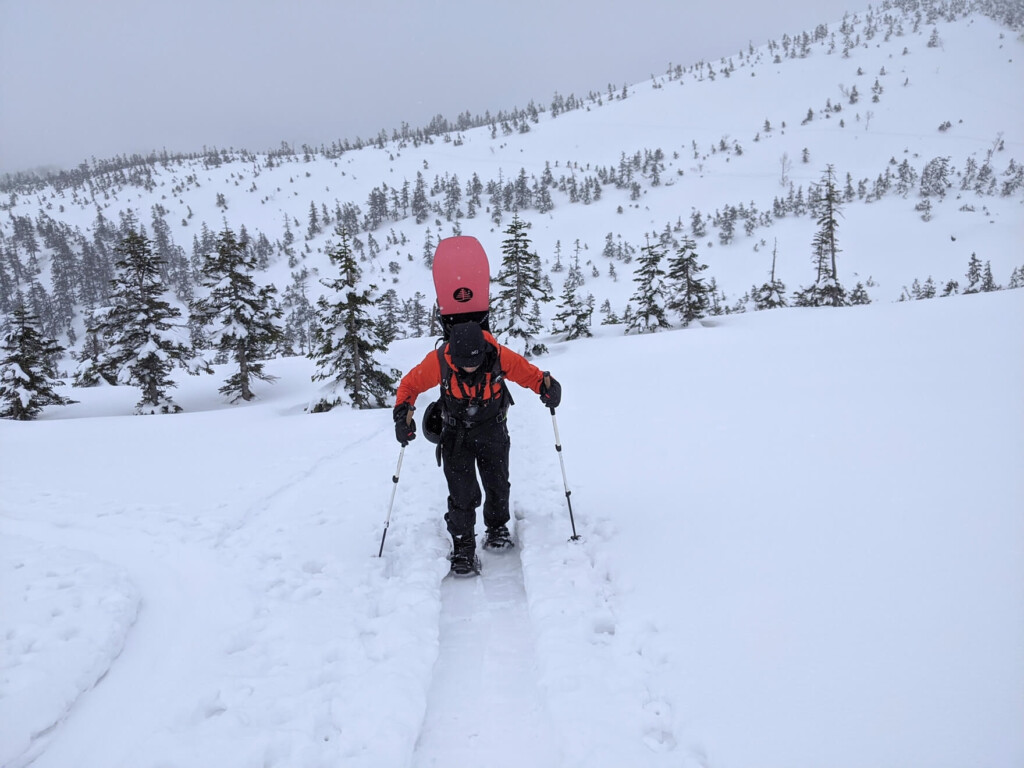
We recommend adjustable length for snowshoes and wide snow basket stock.
Also, when walking on snow, wear a "snow gaiter" that covers your feet to your shins to prevent snow from entering your boots. Without this, if you get hooked on deep snow, cold snow will mercilessly enter your shoes. Don't forget to wear it before you start.
Related Articles
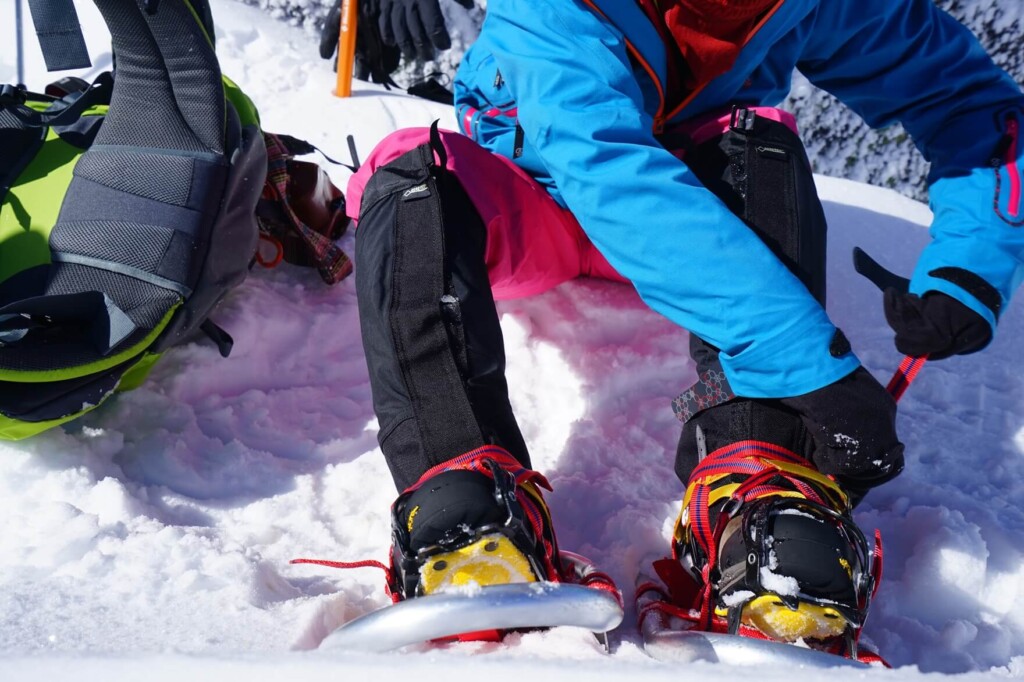
Gators are essential when walking through deep snow.
5 points to check when choosing the best snowshoes
Point 1: Find out the type and type of snowshoe that is suitable for your purpose and purpose
Today's snowshoes are roughly divided into three types depending on the purpose. Each has its advantages and disadvantages, and although there are models that are as well-balanced as possible, there are rarely any versatile models that can perfectly cover them. First, be sure to understand the characteristics of each type of model and understand the type you should buy.
| type | For flat and gentle slopes | For mountainous terrain and backcountry | For running (race) |
|---|---|---|---|
| Representative image |  | 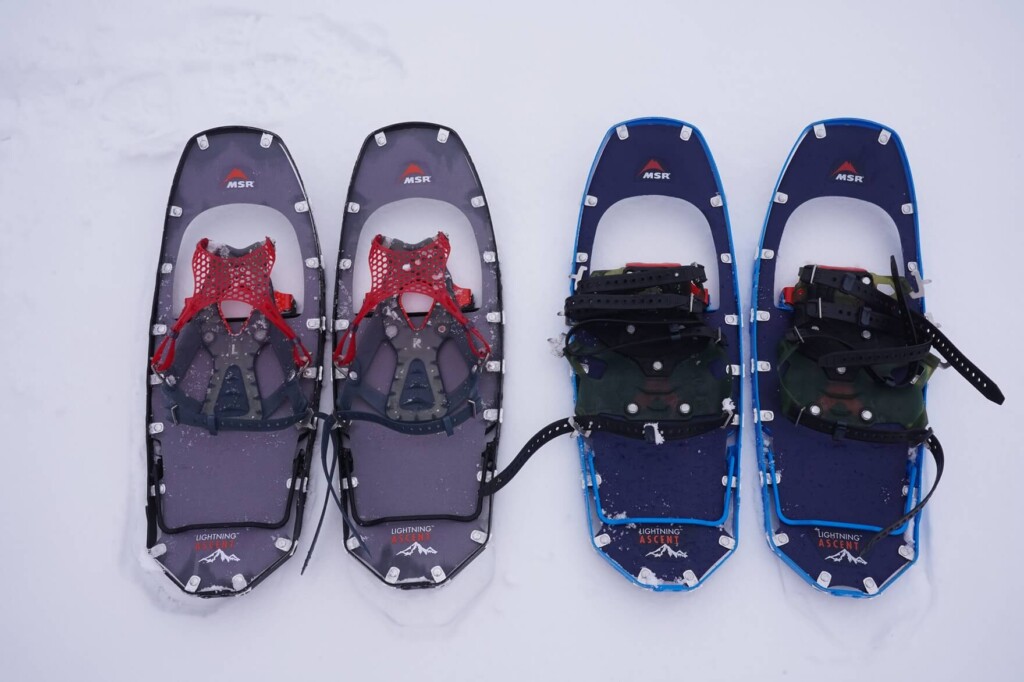 |  |
| Uses | Optimized model for walking from flat to gentle slopes | A model optimized for mountain climbing and backcountry, with the assumption that it will climb and descend on steep slopes | Basically, a model optimized for scenes where you run on grounds with pressed snow |
| Features | Perfect for beginners | Perfect for backcountry and winter mountain climbing | Perfect for running and races on the snow |
| Strength |
|
|
|
| weakness |
|
|
|
Point 2: Choose the frame (& deck) with the optimal material, size and shape
Is it sized to suit the quality and depth of snow?
Now that you know the type that's best for you, the next thing to consider is to check the structure of each model: first, the frame and deck part.
A "frame" is the part of the frame surrounding the snowshoe, and if there is a membrane inside the frame, that part is called a "deck."

Snowshoe frames and decks need to be chosen from a variety of materials, sizes and shapes depending on the main purpose.
In order to float firmly on soft snow, no matter what you place, the size or overall length of is important. Naturally, the larger the frame, the greater the buoyancy , so even deep snow can provide buoyancy, making it easier for large people or people with a lot of luggage to walk around . However, on the other hand, the weight is heavier . For this reason, it is not a good idea to choose an extremely large model.
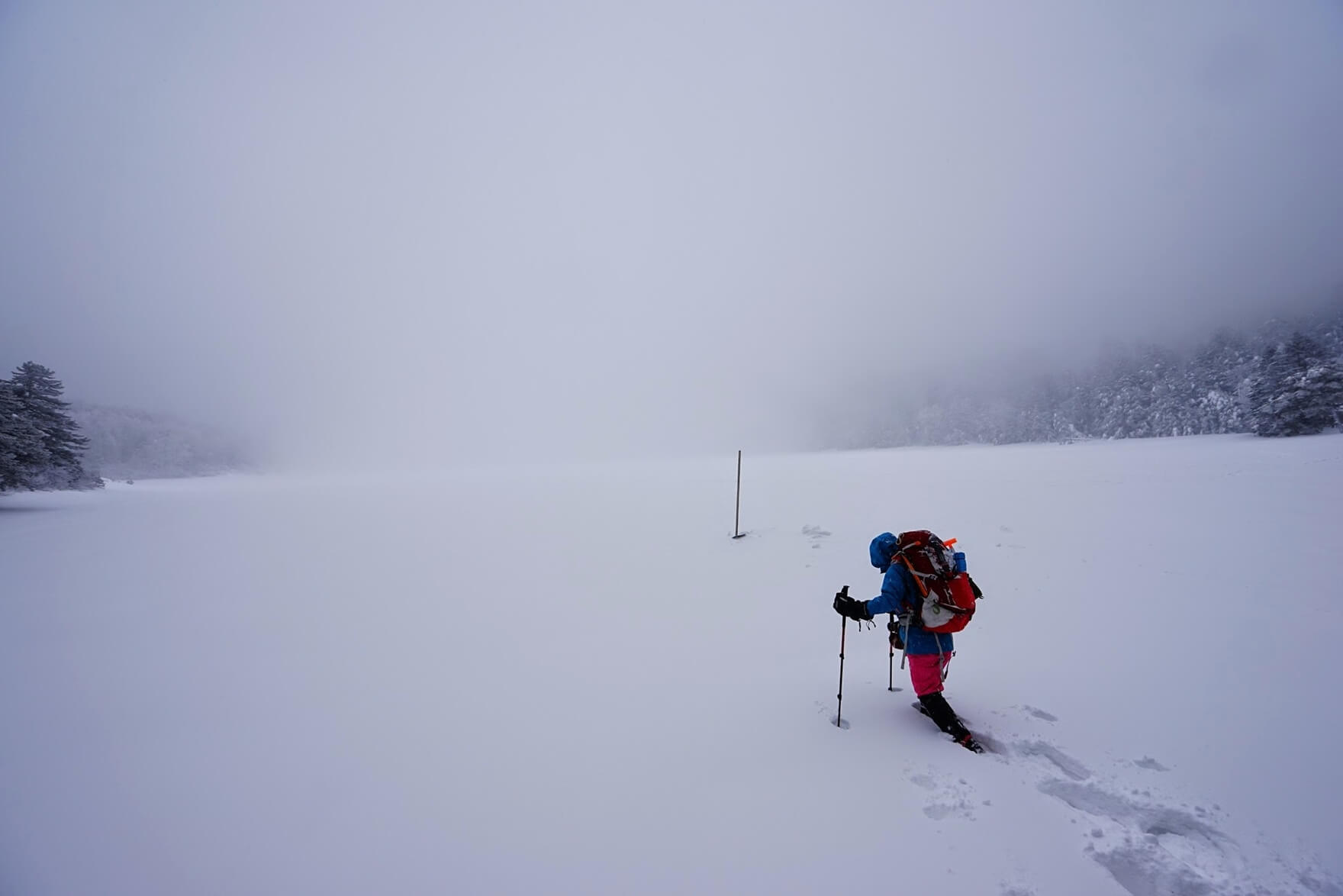
To move through the powder snow, it is difficult to walk without a large frame as your feet sink deeper and it is difficult to walk.
Some manufacturers offer different sizes (total length) for the same model, so if you don't know how long it is appropriate, it's best to consult with a store clerk and your weight + luggage will fit within the "compatible load" of the snowshoes, and choose a comprehensive selection.
Is the material and shape suitable for the terrain of the route you are walking on?
Another thing to keep in mind when choosing the material and edge shape .
Tube type
Snowshoe frames were originally made of wood or bamboo, but most of them have now been replaced by metals or plastics such as aluminum. Wood, bamboo, and aluminum frames are mostly round tube-like, so they have the disadvantage of having weak grip on steeper slopes
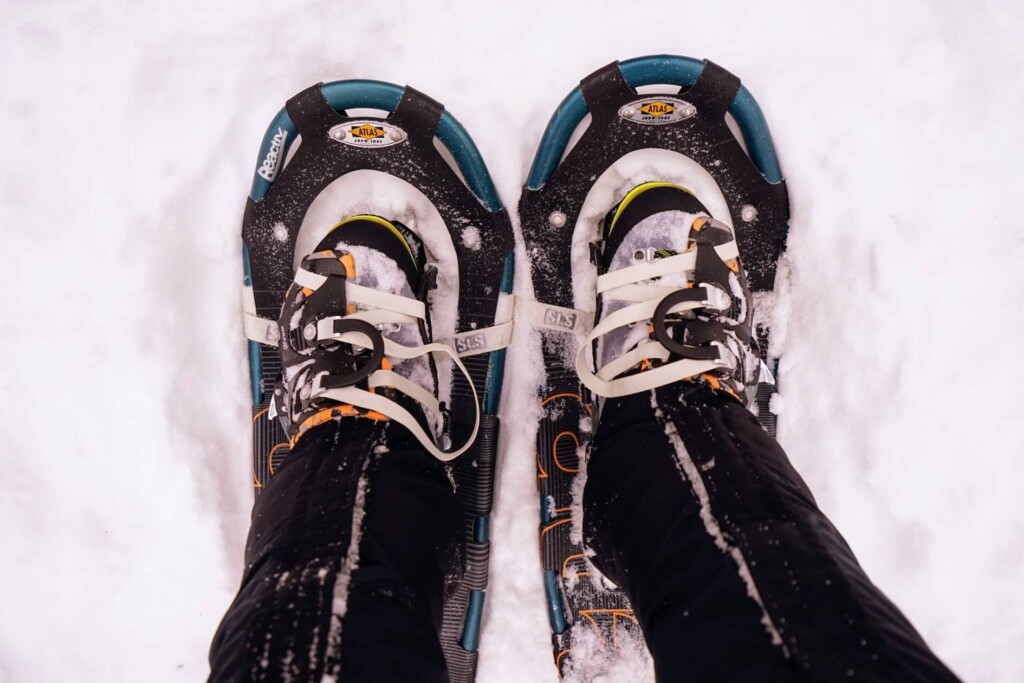
Edge type
Other frame shapes include models made from molded plastic or cornered aluminum plates to create edges on the outer periphery (the photo below shows a plastic edge type frame).
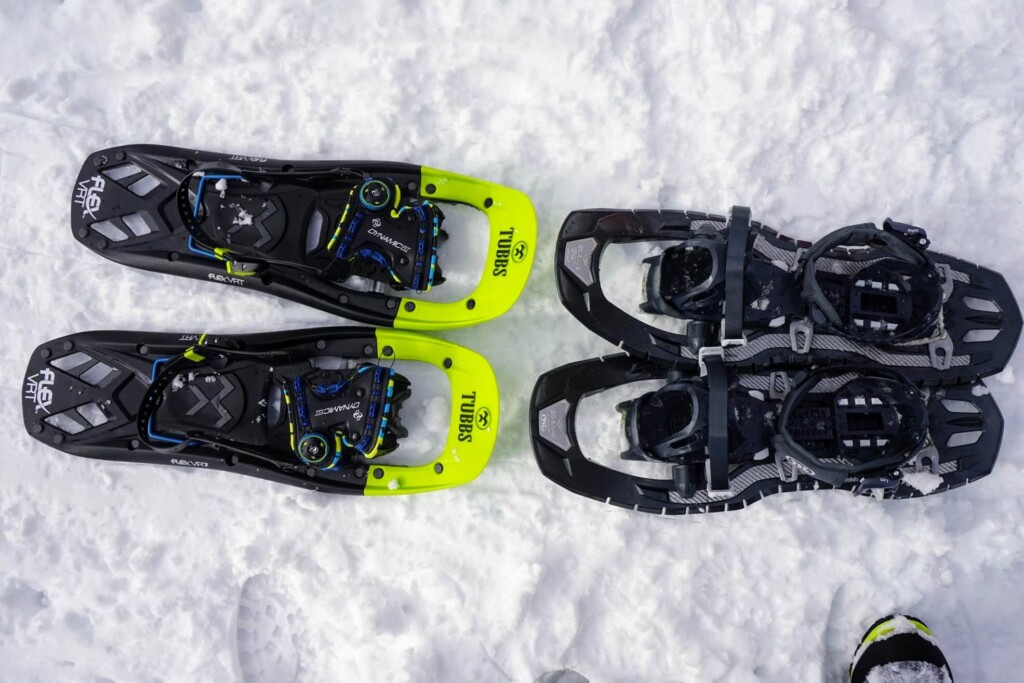
mostly snowshoes made from European brands, which were primarily used to walk on glaciers, and the strong grip of the edges makes them suitable for climbing and downhill slopes, traverses, and walking on hard snowy conditions . Instead, its durability is weaker than tubes, and because it has an edge, it is not very good at walking smoothly (sliding) in deep snow.
Point 3: Choose a binding that is easy to put on and take off and does not loosen
A binding is the part where the shoe is secured to the snowshoes. The fixing method varies depending on the manufacturer and type. This is the quickest thing to do is try on and try it out, but in any case, there are two points to check here:
One is whether it is easy to put on and take off . Putting on and taking off while wearing gloves is often difficult, and even if you can easily do it with your bare hands, it can be difficult to do it in actual work.
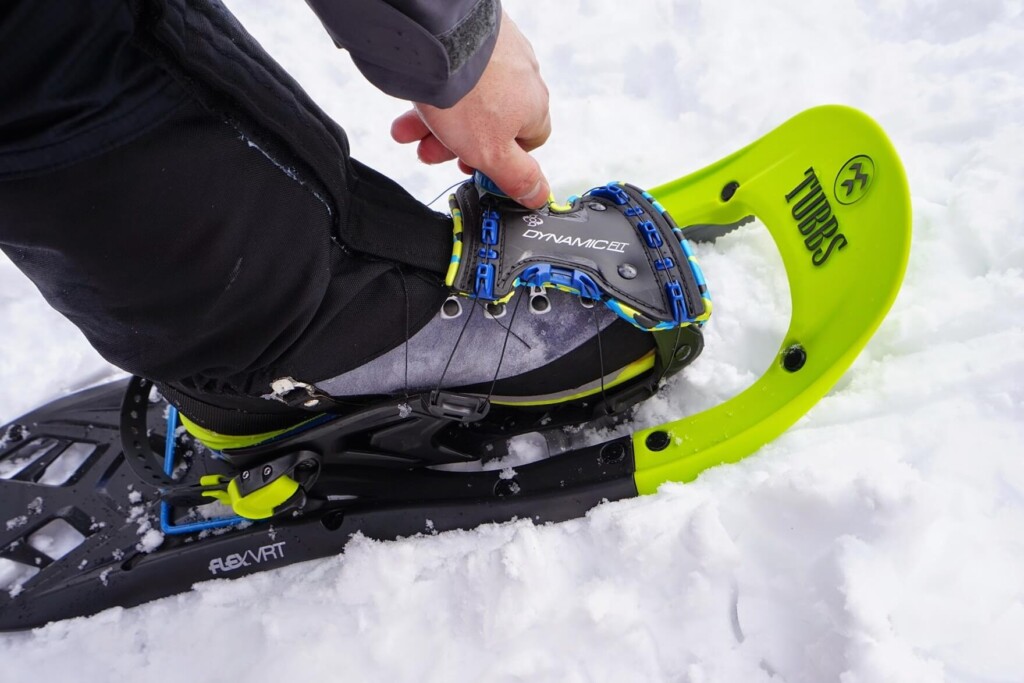
The bindings differ in speed and fit. I'd like to try it on and compare it.
Another important point is whether it is difficult to loosen up even after walking for a long time This is something you won't know unless you actually walk for a long time, but even when trying on, you can check to a minimum to a minimum to see if it doesn't loosen up even if you try on. Even if you can only check the specifications, make sure you check as closely as possible to make sure these two points are solid bindings.
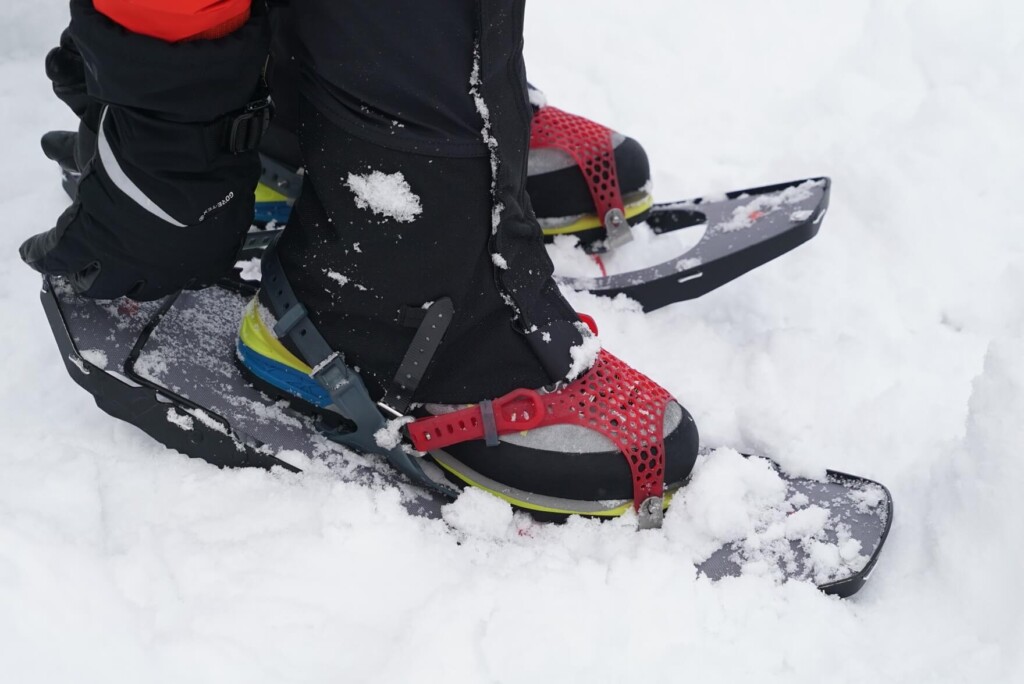
It is important to make the bindings securely secure the entire foot, but it is also important to wear them in the correct way recommended by the manufacturer.
If you are planning to use it for serious mountain climbing, be sure to check whether the heel has a heel lift to help you climb on steep slopes

For beginners, there are models that do not have heel lifts, and in the case of snowshoes, it is difficult to walk on steep slopes.
Point 4: Check whether the clamp is strong enough to suit your needs
Larger and deeper claws are needed on steeper slopes
A clamp is the jagged claws (spike edge cleats) on the back of a shoe.
As many people imagine, this can cause snowshoes to bite into the snow surface, making them less likely to slip, and improve grip, which can vary greatly depending on the shape, size, material, etc. As expected, I don't know how effective this is until I actually walk along a snowy slope, but here I will explain how to check it before purchasing.
The strength of the clamp, no matter what, first of all, is "depth and size (sharpness)".
Of course, the depth and size (sharpness) of the clamp has a major impact on the strength of the grip. The large, sharp claws can firmly penetrate the ground even on harder, steep slopes, allowing you to walk safely.
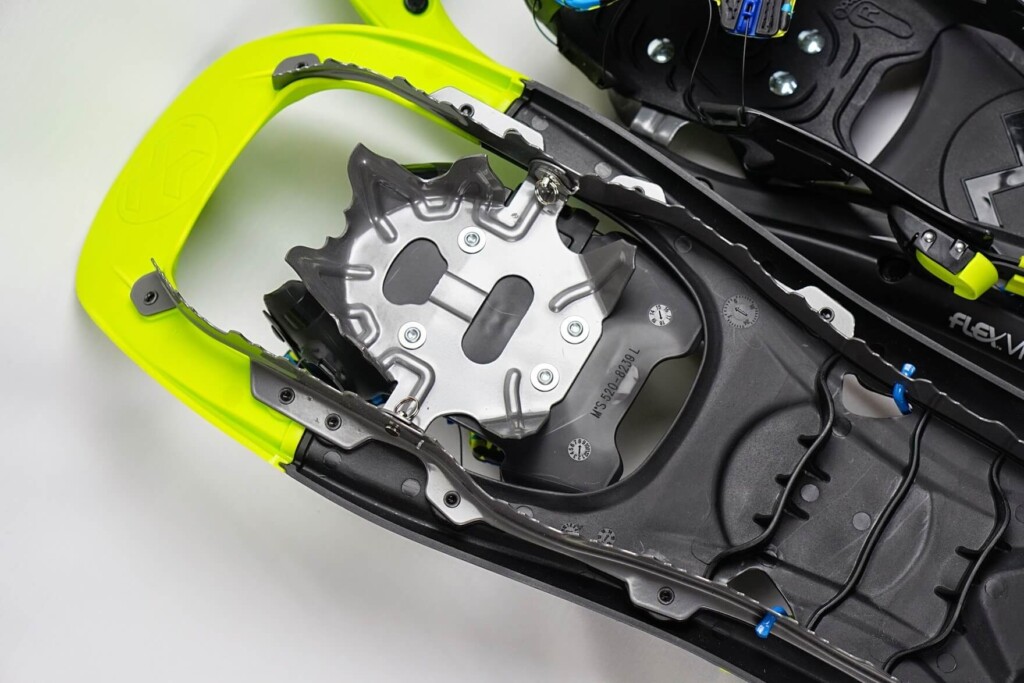
"Claw arrangement and orientation" that creates stable grip over a variety of terrain
Next, check how much the clampon is on the back of the shoe, and how much it is located and direction. Depending on the model, we can see that there are various models, from those that are only located on the toes of the feet, to those that are placed entirely on the soles of the feet, and even around the outer circumference of the frame. Of course, this is considered more stable because it would be better to choose a model with a wider range of claws placed on this point, as it will give you a better grip regardless of how your feet are placed.

The number and size of the claws increase grip, but it becomes heavier. A minimum number is desirable that suit your purpose.
Also, the direction in which the nail bites in can lead to differences in whether the nail is simply thought of pushing forward in the front and back direction, or whether it is difficult to slip sideways (assuming slope traverse, etc.), and whether it is thought to be able to hold back when it shifts in the horizontal direction.
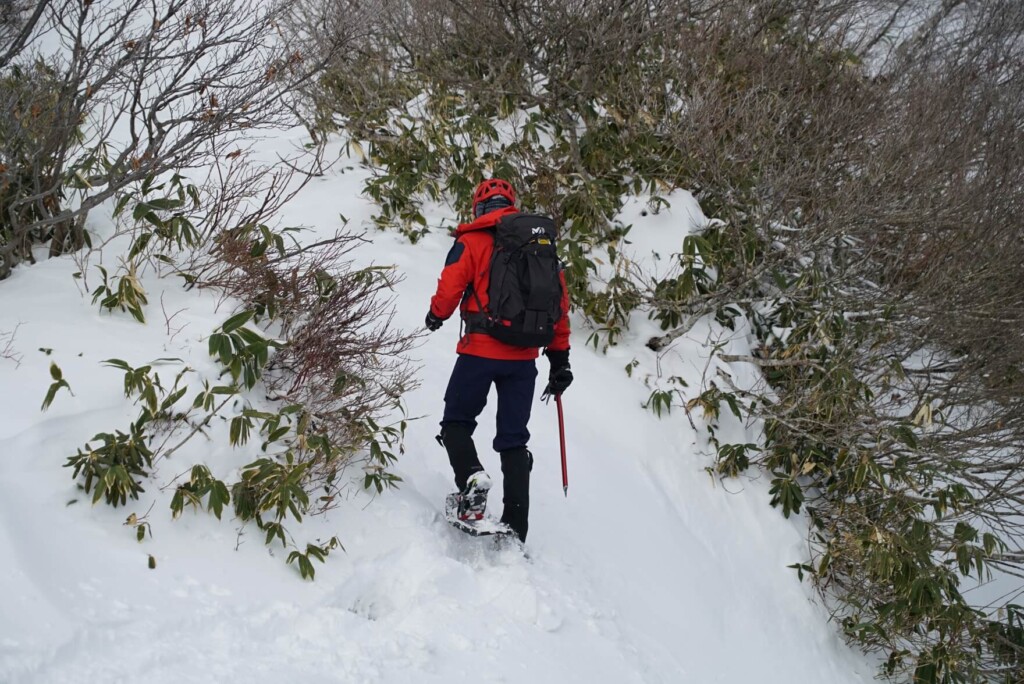
For example, if the clamp is only on the toes, it may be difficult to step on the slope due to traverses or other factors.
Finally, depending on the structure of the clamp, heavy snow such as wet snow may become clogged while you are walking (photo below). This is especially common among North American manufacturers where there is a lot of dry, dry snow, but be careful of models with tight spacing between the clamps and arrangements that do not seem to make snow slipping out well.
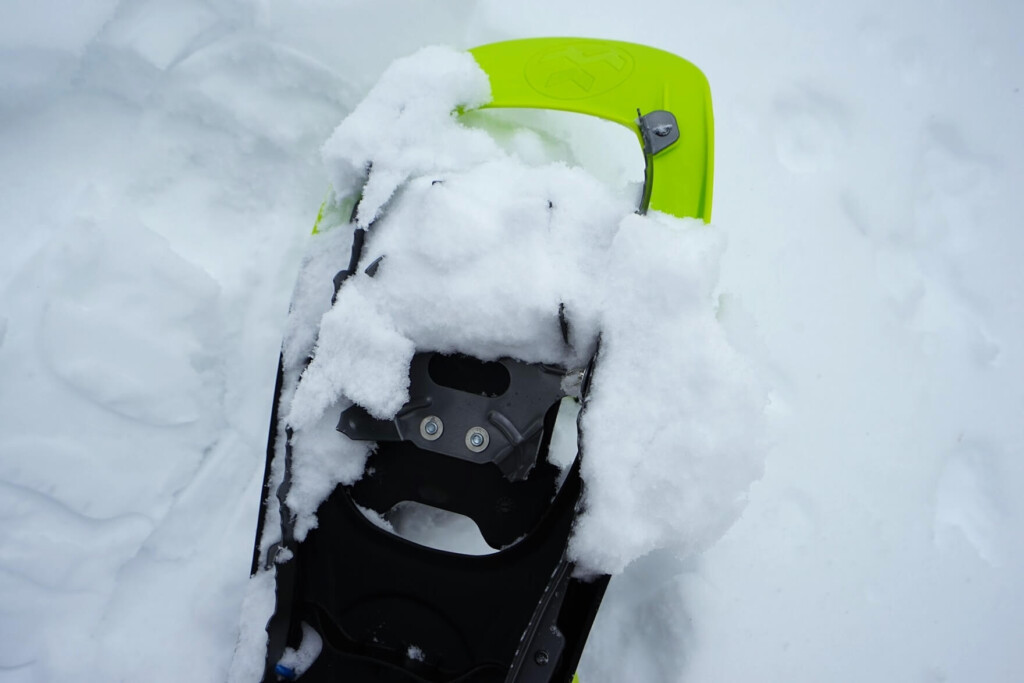
If the clamp is too large and too dense, if there is heavy snow, snow can become clogged between the clamps while walking.
Point 5: Weight and portability are also important depending on the purpose
If you keep this close, you won't be able to make a big mistake, but in the end, if you still can't squeeze it out, consider this last checkpoint: weight and portability.

When choosing snowshoes suitable for mountain climbing or backcountry, the key point is whether they are lightweight and easy to pack.
If you're going for a day trip for a few hours, you won't be able to take off your snowshoes from the start to the finish line, but if you're going to climb a snowshoe that's like a snowy mountain that goes through a deep snow forest and then come out onto the ridge, there are often scenes where you take off your snowshoes and attach them to your backpack, and then re-wrap them when descending the mountain. In that case, some models may find snowshoes that are surprisingly thick, so it's better to have a lighter weight that won't get bulky when attached to a backpack and not too difficult to carry around. Even if you don't have any plans now, you won't be regretted later, so even with the features you need, we recommend choosing a model that is as light as your budget can afford.

No matter how easy it is to wear snowshoes, if you have the possibility to carry them around, consider portability.
Recommended snowshoes by purpose and type - From snow hiking to backcountry
This time, I have not been able to wear the latest models in the actual product, but based on my experience wearing the series so far, I have come up with some recommended models that suit my purpose and style for 2022.
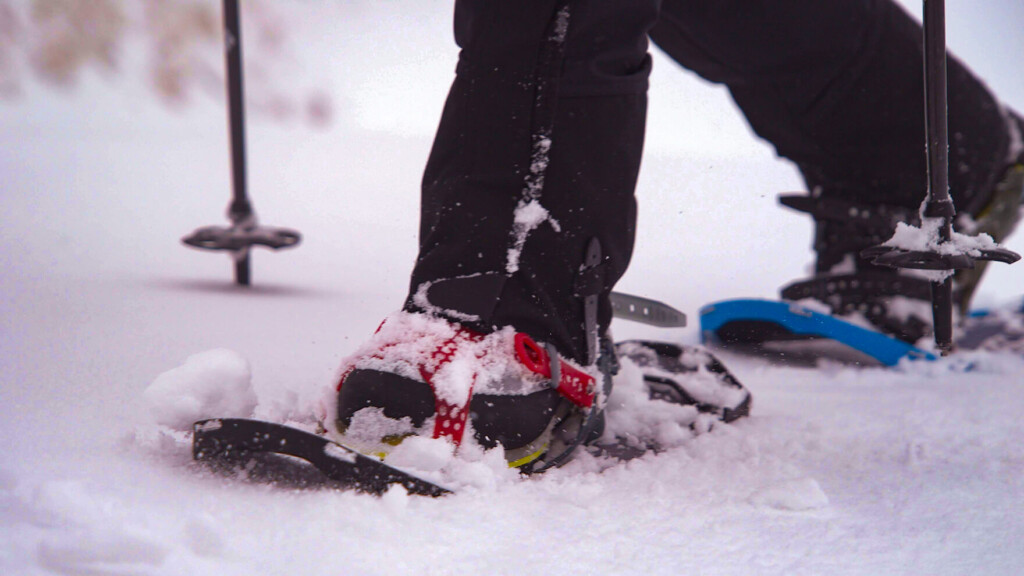
Recommended snowshoes for backcountry: MSR Lightning Ascent
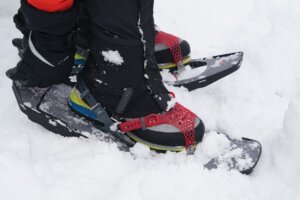
It is one of the most expensive snowshoes, but it boasts top-class walking performance, which can accommodate flat lands, steep slopes, and technical terrain. It is said to be called the Rolls-Royce of the snowshoe world.
First of all, the entire outer periphery of the frame is sharp and blade-like, so the grip is incredible both in the vertical direction of the steep slope and in the horizontal direction of the slope traverse.
The binding is super lightweight and simple, and is extremely quick to put on and take off. It fits easily with any shoe. Of course, it comes with a heel lift, so it's not a problem on steep slopes, making it so easy to use, and even lightweight and compact. The most attractive feature is its safety, which has almost no drawbacks when it comes to "climbing." This feature is perfect for backcountry snowboarders who are only needed to climb tough terrain. It is truly perfect for backcountry, and of course it can be used for all the harsh snowy mountain activities.
Recommended snowshoes for all-around games: Atlas Range Series (MTN/BC)
Most of the former main models of North American snowshoe maker ATLAS were simple aluminum tube frames. It has evolved remarkably over the past few years.
The frame cross section of the latest flagship model, the Range Series, is a T-shaped aluminum frame with excellent balance of rigidity, lightness and flexibility. The saw blade shape on the outer edge of the frame and the structure that produces moderate flexibility provide excellent grip, and it has enough performance to become a prominent competitor for the MSR Lightning Ascent, which has been the norm until now.
The MTN model has a dial-type binding with the BOA system, making it a perfect fit for any shoe and is designed to be comfortable and not easily loosened while walking. The BC model is designed to be portable and fit with a lightweight, compact resin band. No matter whichever you choose, these snowshoes are all-round, offering a wide range of options, from gentle snowfields to complex terrain.
Recommended snowshoes for beginners: Atlas Helium TRAIL 23
Based on not-to-date but proven materials and structures, it is designed with no quirks that can be used in any purpose. It also has simplicity and ease of use in detail, and is priced as easy to pick up as possible. This Atlas Helium TRAIL 23 is a reliable and recommended for beginners.
Of course, there are models that are more simple and gentle on the terrain, but if they do, they may not have a heel lift, which makes them unsatisfied when you step up. In this regard, Helium TRAIL can handle a surprisingly wide range of terrains, from beginners to terrains with a certain slope, so we recommend "just just right" that can be used for a long time.
Snowshoes are comfortable to walk in and recommended for snowy mountain climbing: TSL SYMBIOZ hyperflex adjust
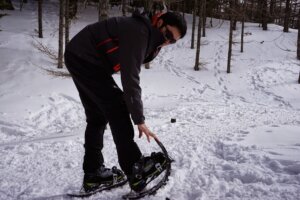
I like it, TSL. It doesn't seem to sell very well in Japan... This flagship model is a long-established manufacturer in France, a snowshoe powerhouse known only to those who know about it, and is extremely comfortable to walk in thanks to its unique frame structure.
The tiny grooves on the sides of the frame and special plastic make the snowshoes surprisingly flex. Despite wearing shoes, you can walk in a natural way, just like you're wearing regular shoes. The latest model uses a BOA system to provide a perfect binding for both detachment and fitting, allowing for performance that is free from enemies except for the difficulty of packing. This ease of walking and safety of grips in all directions is ideal for climbing snowy mountains and snotrekking over a variety of snowy qualities and terrain. I wonder if the biggest problem can be purchased in Japan? That's what it means. If you are interested, you may want to contact your sales agent.
Recommended snowshoes for cost performance: Captain Stag UX-950 CS Snowshoes TYPE II 22inc
Aside from the suspicious Chinese brands, Captain Stag, also known as the Chief Japanese brand that offers wallet-friendly outdoor goods, has a wide range of snowshoes, from introductory models to kids and full-scale mountain climbing. In particular, the UX-950 is not particularly unusual in functionality or structure, and although it is a snowshoe with a basic structure of a polyethylene fabric deck attached to an aluminum tube frame and a plastic binding that holds the toes and heels at three points, it can be said that it has undoubtedly adept and ease of use. It comes with a carry case, but is still at a great price.
Conversely, you can't want much. Since it does not have a heel lift, it is suitable for flat and gentle slopes, and the size of 22 inches may not be able to float if it is heavy due to deep snow. However, if you absolutely have to minimize costs, this is a good option.
summary
If you think of snowshoes as simple as "walking on deep snow," it may seem like the same thing no matter which one you choose, but there are surprisingly few pitfalls. An acquaintance who used to go backcountry as a hiking model, and while everyone was moving smoothly, I was only filled with legs quite a bit, exhausting my physical strength. Because of this, you should not simply choose the model based on the price alone, but rather wisely choose a model that is sure to suit your purpose and situation.
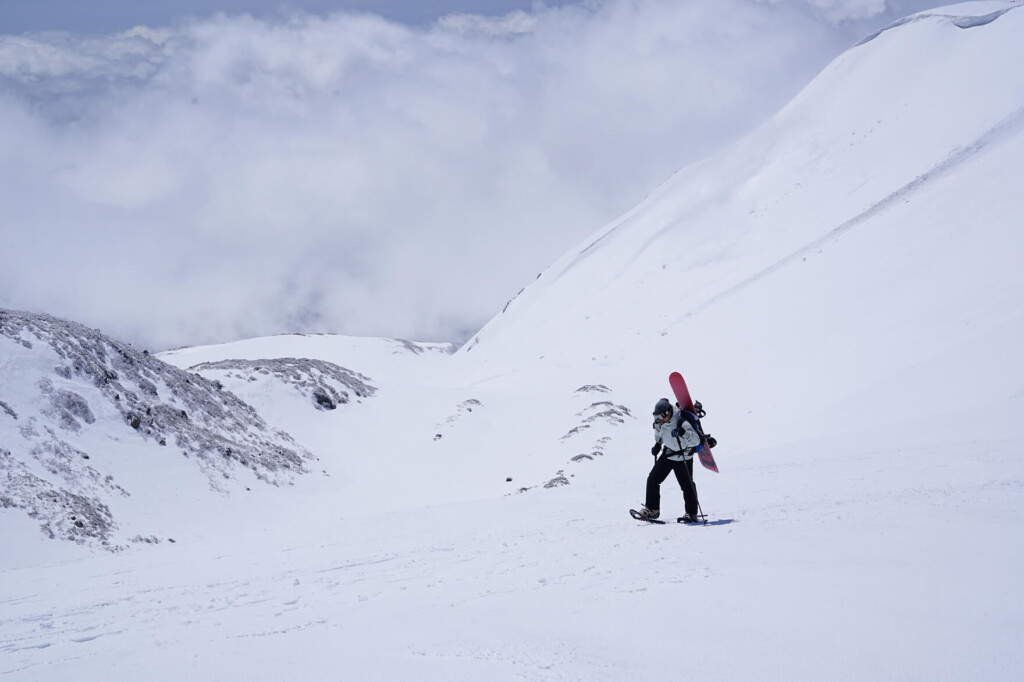




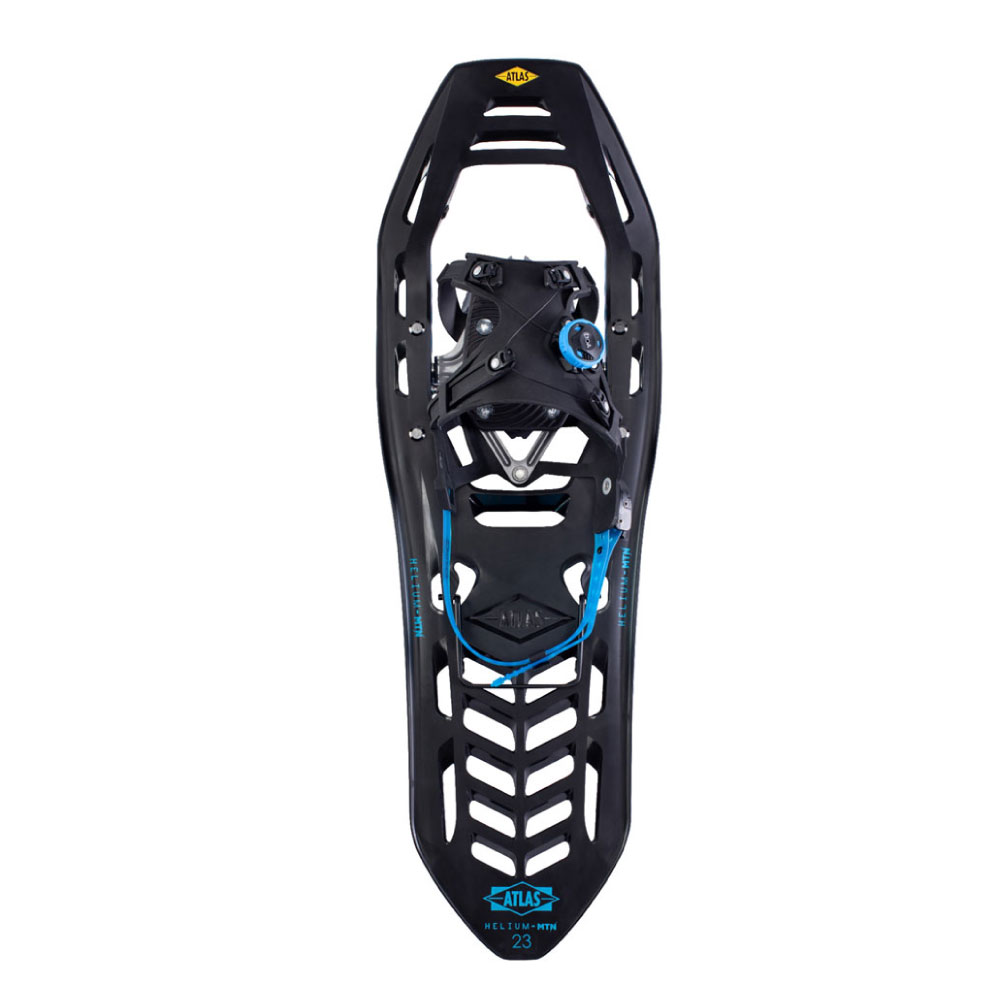


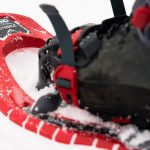 Comparison of lineup: We've compared TSL snowshoes, a talented person only knows, so we'll introduce some recommended models.
Comparison of lineup: We've compared TSL snowshoes, a talented person only knows, so we'll introduce some recommended models.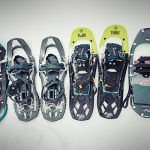 Comparison review: Comparing shoes from the four major snowshoe manufacturers, MSR, ATLAS, TSL, and TUBBS!
Comparison review: Comparing shoes from the four major snowshoe manufacturers, MSR, ATLAS, TSL, and TUBBS!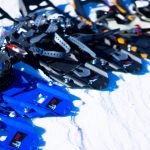 Lineup comparison: We compared MSR snowshoes, so we'll introduce some recommended models.
Lineup comparison: We compared MSR snowshoes, so we'll introduce some recommended models.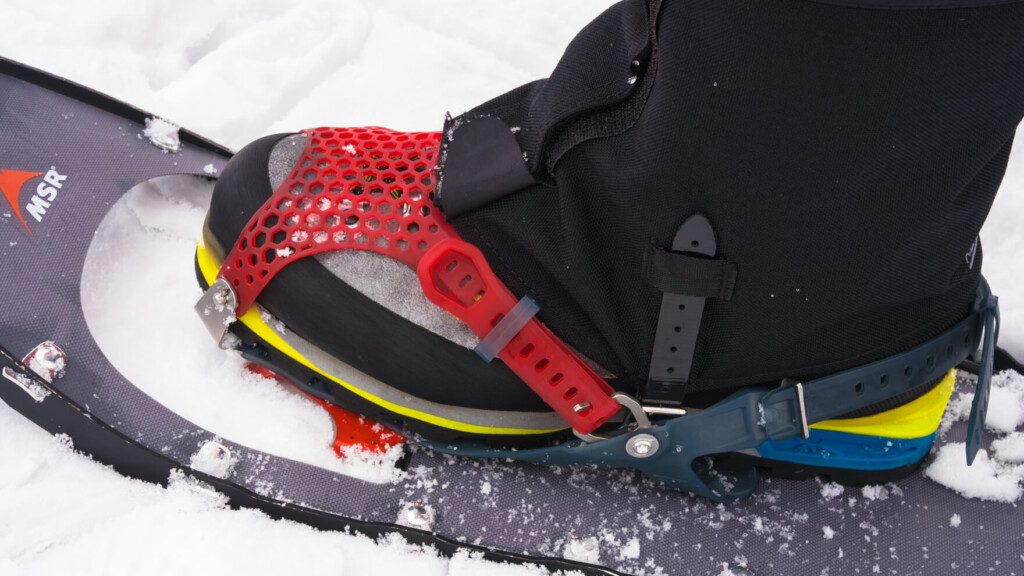 Review: MSR Lightning Ascent The evolved bindings are comfortable to go back once you experience them! [Comparison of new and old models]
Review: MSR Lightning Ascent The evolved bindings are comfortable to go back once you experience them! [Comparison of new and old models]